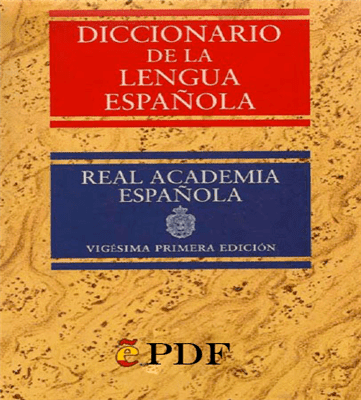Originally published 1780 Genre Dictionary | ||
 | ||
Similar Dictionary books, Other books | ||
Descargar diccionario completo de la lengua espa ola por mega para pc
The Diccionario de la lengua española, also known as the Diccionario de la Real Academia Española (DRAE), is the authoritative dictionary of the Spanish language. It is produced, edited, and published by the Real Academia Española (RAE – Royal Spanish Academy). It was first published in 1780, since when new editions have been published about once a decade. The twenty-third edition was published in 2014.
Contents
- Descargar diccionario completo de la lengua espa ola por mega para pc
- edici n del tricentenario del diccionario de la lengua espa ola por luis fernando lara
- Origin and development
- Formats
- Titles throughout history
- Inaccuracy
- Pejoratives
- References
edici n del tricentenario del diccionario de la lengua espa ola por luis fernando lara
Origin and development
When the RAE was founded in 1713, one of its primary objectives was compiling a Castilian Spanish dictionary. Its first endeavor was the six-volume Diccionario de Autoridades (Dictionary of Authorities) from 1726 to 1739. Based on that work, an abridged version was published in 1780, the full title of which was the Diccionario de la lengua castellana compuesto por la Real Academia Española, reducido á un tomo para su más fácil uso (Dictionary of the Castilian language composed by the Royal Spanish Academy, reduced to one volume for easier use). According to its prologue, the dictionary was published for general public access to a dictionary during the long time between the publishing of the first and second editions of the exhaustive Authorities Dictionary, thus offering a cheaper reference book; by the time the second edition was published, it had become the principal dictionary, superseding its ancestor; the last edition of the Diccionario de Autoridades was published in 1793.
The fourth edition (1803) introduced and incorporated the digraphs ch (che) and ll (elle) to the Castilian alphabet as separate, discrete letters in alphabetic organization. That incorporation was overturned in 1994 (at the tenth meeting of the Asociación de Academias de la Lengua Española) where they were re-ordered in concordance with the Latin alphabet. Also in 1803, the letter "X" was replaced with "J" when its pronunciation was identical to that of the guttural "J", and the circumflex accent (^) was eliminated.
The earliest editions were more extensive: they included Latin translations of the entry, in some cases gave usage examples (especially in popular phrases), and summarized the word's etymology; contemporary editions do so concisely. The earliest editions had "X" entries that no longer appear individually.
Historically, the decision to add, modify, or delete words from the dictionary has been by the RAE, in consultation with other language authorities (especially in Latin America) when there was an uncertainty. This process continued between 1780 and 1992, but, since the 1992 edition, the RAE and the twenty-one discrete language academies of Latin America collaborate in producing the Dictionary of the Spanish Language.
Formats
Until the twenty-first edition, the DRAE was published exclusively on paper. The 2001 edition was offered on CD-ROM and paper. The twenty-second edition was published in three formats, paper, CD-ROM, and on the Internet with free access. The current, online version is a hybrid of the most recent print edition (the twenty-second), and the future, twenty-third edition, incorporating modified definitions that will eventually constitute the twenty-third edition.
Titles throughout history
Inaccuracy
Some entries in the dictionary do not reflect current scientific understanding. A clear example is its definition of dinosaurio ("dinosaur"), which refers only to sauropodomorphs.
Pejoratives
In 2006, The Spanish Federation of Jewish Communities complained that some of the dictionary's entries and definitions about Judaism were racist and offensive. One definition of sinagoga (synagogue) is: "a meeting for illicit ends"; the nominal definition of 'synagogue' is given first, and the pejorative definition is so identified.
Yerba-buena, an association of Spanish Gitanos ("Gypsies" in English), complains that one definition of Gitano: "one who practices deceit" or "one who tricks", is offensive and could encourage racism; nevertheless, the word gitano does actually mean "trickster" in Spanish, and other Spanish dictionaries include this definition.
Galicians take offense to the definition of Gallego: "a Galician, dumb, stupid or deaf." Some of these groups propose deletion of these pejorative definitions, while others feel that the entries should be flagged as offensive.
The RAE dismissed the complaints as political correctness, saying "we simply photograph the landscape; we do not create it".
